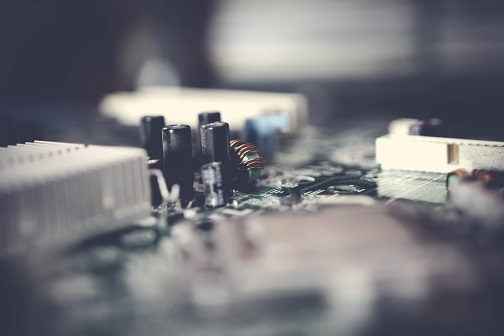“Pros” and “Cons” of Solid-State Capacitors

The dielectric of the liquid electrolytic capacitor is liquid electrolyte, and the liquid particles are very active at high temperature, which generates pressure on the inside of the capacitor, and its boiling point is not very high, so it may explode.
Solid-state capacitors use polymer dielectrics. At high temperatures, solid-state particles have lower particle swelling or activity than liquid electrolytes. Its boiling point is also as high as 350 degrees Celsius, so it is almost impossible to explode. In theory, it is almost impossible for solid capacitors to explode.
Compared with traditional electrolytic capacitors, solid capacitors have better performance in equivalent series impedance. According to tests, the equivalent series resistance of solid capacitors is extremely small when operating at high frequencies, and the conductivity frequency is excellent, which can reduce electrical impedance and The characteristic of lower heat output is most obvious between 100KHz and 10MHz.
▲ Solid Capacitor
Traditional electrolytic capacitors are more easily affected by the temperature and humidity of the operating environment, and are slightly less stable in high and low temperature. Even at minus 55 degrees Celsius to 105 degrees Celsius, the ESR (equivalent series resistance) impedance of solid capacitors can be as low as 0.004 to 0.005 ohms, but electrolytic capacitors will change due to temperature.
▲ Electrolytic capacitors
In terms of capacitance value, liquid capacitors below 20 degrees Celsius will be lower than the marked capacitance value, and the lower the temperature, the lower the capacitance value will be.
At minus 55 degrees, the electric capacity reaches 37%.
Of course, this has no effect on ordinary users, but for players who use liquid nitrogen for the ultimate overclocking, solid capacitors can ensure that the capacitor capacity will not be affected due to the temperature drop, which will lead to greatly reduced overclocking stability. Because the capacitance value of solid capacitors will only drop by less than 5% at minus 55 degrees. Solid-state capacitors do have a lot of advantages, but they don’t work all the time.
The low-frequency response of solid capacitors is not as good as that of electrolytic capacitors. If we use them in parts involving sound effects, we can not obtain the best sound quality. In other words, it is not necessarily the most reasonable for a motherboard to use all-solid capacitors!
Whether it is a solid capacitor or an electrolytic capacitor, their main function is to filter out clutter. Therefore, as long as the capacity of the capacitor reaches a certain value, it can also ensure the stable operation of the motherboard as long as the quality of its components passes the test. And this, electrolytic capacitors can also do it!
When the solid capacitor is at 105 degrees Celsius, its lifespan is the same as that of electrolytic capacitors, which is 2000 hours. After the temperature is lowered, their lifespan will increase, but the lifespan of solid capacitors increases more greatly. Generally, the working temperature of the capacitor is 70 degrees. or lower.
At this time, the life of solid capacitors may reach 23 year. Which is almost more than 6 times that of electrolytic capacitors! But…will your motherboard still be around in 23 years? And this 23 years refers to 24 hours a day. Even if the capacitor has such a long life, other components may not last 23 years!
Compared with electrolytic capacitors, solid capacitors have a much larger capacity than solid capacitors under the same volume and voltage. At present, most of the CPU power supply parts of computer motherboards use solid capacitors. Although we avoided the problem of pulp explosion, due to volume limitations, the capacity redundancy is very high. In addition, due to the capacity problem, the switching frequency of the CPU power supply part has to be increased.
Both solid capacitors and electrolytic capacitors will have capacity attenuation problems during use. However, if the capacity of the circuit board using solid capacitors fluctuates slightly, the power supply will ripple. It causes the CPU to not work properly. Therefore, in theory, the lifespan of solid-state capacitors is very high. But the lifespan of boards using solid-state capacitors is not necessarily high.
Maintenance of computer boards with solid capacitors: Since we often connect the power supply part of the CPU with multiple capacitors in parallel, and we will not deform, explode and leak the solid capacitors. There is basically no way to visually judge which one is faulty. Therefore, in maintenance, we often remove one of them(whether good or bad), and replace a large-capacity capacitor. This method can generally solve the problem quickly.
Theoretically, the lifespan of solid-state capacitors is very high, but there are still many failures in the actual use process. The author has encountered capacitor failure problems many times during the maintenance process.
At present, it seems that the motherboards with overclocking as their selling point mostly use solid capacitors. The statement that “the motherboard with solid capacitors can exceed the performance” is just barely correct. And it is not the capacitor that determines the overclocking.
Circuit design, BIOS development, the quality of the CPU itself, and cooling measures may all determine the success or failure of overclocking. So there is no saying that “replacing ordinary electrolytic capacitors on the motherboard with all-solid capacitors can improve the overclocking performance of the motherboard”, this statement is completely wrong!
If you really want to talk about the impact of solid capacitors on overclocking, it is because it has higher voltage and temperature resistance capabilities, so it provides a certain guarantee for the stability of the system after overclocking.




